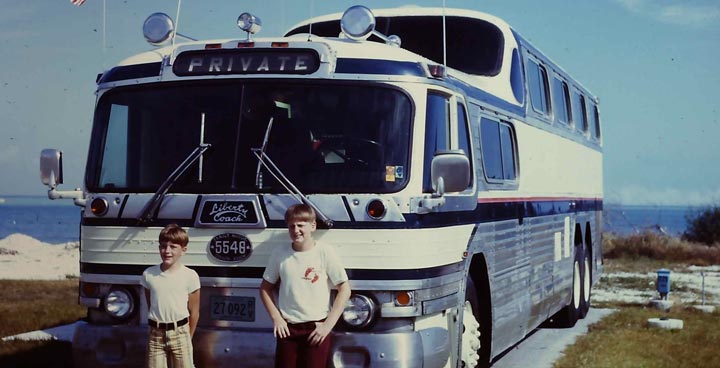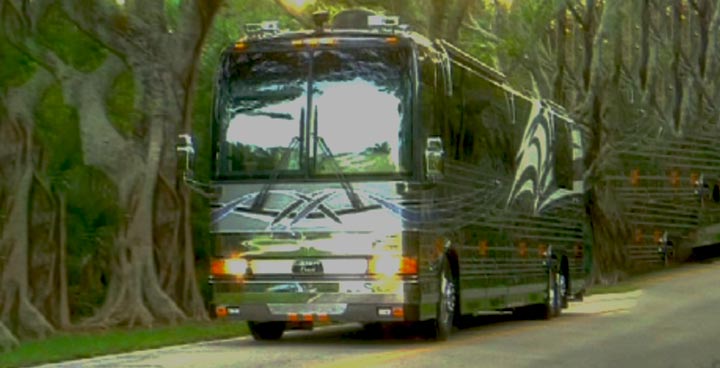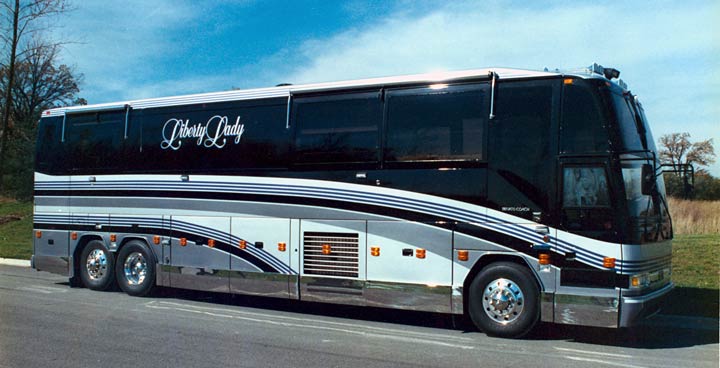The Scenicruiser Story
EDITOR’S NOTE: In the 1970s, Liberty built its coaches on used passenger buses purchased from Greyhound Bus Lines in Chicago. This excerpt from Jeanne Konigseder’s unpublished memoir, the fourth in a series, offers an in-depth look at one of the most memorable models.
Of all the Greyhound buses you’d see on American highways in the 1950s and 60s, the GMC Scenicruiser was the most iconic, thanks to the unmistakable 2-level design based on the stainless steel “dome cars” then popular on passenger trains.
By 1973, though, Greyhound was looking to unload their Scenicruiser fleet and approached us and another family in the Chicago area to see if we could convert them into motorhomes. Why not???
Well, it wasn’t the easiest bus to work on. The units had a center aisle and the seats were on a 10-inch raised platform running down both sides of the coach. All the running lines necessary for operation of the bus ran through this raised area, so they had to be relocated to the baggage area so the platform could be lowered enough to clear headroom for the bathroom and kitchen.
As a result, a lot of reengineering and mechanical work had to go into this unit before an interior could be undertaken. For that reason, we decided to build the first one in the backyard of our Foundry in North Chicago. Much of the work was done by our part-time machinist mates from Great Lakes Naval Training Center who worked for us in our machine shop.
The bus was about three-quarters finished when disaster struck. Late one night after we had all gone home, fire broke out at the Foundry. We got the call and rushed down there to find the most heart-wrenching sight imaginable – our building, and our business, literally going up in flames. It took a few minutes before we thought of the bus in the back. Work had been in process on the fuel lines, so fortunately they were not connected when the fire struck. We were able to get it out safely and back to the house in Libertyville, where work resumed.
Our plan was to show this bus at the FMCA convention downstate in Du Quoin, so the pressure was on to finish fast. With the help of another family that was converting Greyhounds who joined us for a solid week working day and night, we got the job done.
It was well worth the effort. That Du Quoin convention was one of the best ever. The town held a parade led by their emergency vehicles that tracked through the fairgrounds, where a long line of coaches joined and drove into town. With about 1,500 coachers in attendance, the convention put a lot of pressure on the town’s resources; laundromats ran out of hot water and restaurants out of food. No problem – the coaching community was ready and able to step up. At that time, the FMCA was organized into state chapters, whose delegations were eager to engage in a little friendly competition, trying to outdo each other in providing impromptu potluck dinners, evening entertainment, social events and more. It was a happening, and a great time was had by all.
The coach was a hit, and Liberty Coach was on its way. We converted two more Scenicruisers before moving on to the next Greyhound platform, the MC-5 from Motor Coach Industries. But that’s another story.
NEXT IN THE SERIES
Jeanne recalls the often tiring travails of converting ‘million-mile coaches’ in “The Little Engine That Couldn’t”.







